 W
WA petroglyph is an image created by removing part of a rock surface by incising, picking, carving, or abrading, as a form of rock art. Outside North America, scholars often use terms such as "carving", "engraving", or other descriptions of the technique to refer to such images. Petroglyphs are found worldwide, and are often associated with prehistoric peoples. The word comes from the Greek prefix petro-, from πέτρα petra meaning "stone", and γλύφω glýphō meaning "carve", and was originally coined in French as pétroglyphe.
 W
WRock art in Denmark differs significantly from that of the Scandinavian peninsula. Carvings are smaller, focused on agriculture, rarely figural. Some examples are engraved on megaliths or cists, but most on small glacial erratics. Many of these have been placed in museums or incorporated into churches. A few have been left in situ, like the two stones at Mandbjerghøj.
 W
WA pictogram, also called a pictogramme, pictograph, or simply picto, and in computer usage an icon, is a graphic symbol that conveys its meaning through its pictorial resemblance to a physical object. Pictographs are often used in writing and graphic systems in which the characters are to a considerable extent pictorial in appearance. A pictogram may also be used in subjects such as leisure, tourism, and geography.
 W
WThe Ancient Rock Carvings of Sindh have been explored in Kirthar Mountains Range, Sindh, Pakistan. The Kirthar Mountains Range covers a distance of 190 miles in boundaries of Jacobabad District, Qambar Shahdadkot District, Dadu District and Jamshoro District from north to south up to Karachi, Sindh.
 W
WThe Angono Petroglyphs are petroglyphs carved into a rock wall in Angono, Rizal, Philippines. It consists of 127 human and animal figures engraved on the rockwall probably carved during the late Neolithic, or before 2000 BC. They are the oldest known work of art in the Philippines. These inscriptions clearly show stylized human figures, frogs and lizards, along with other designs that may have depicted other interesting figures but erosion may have caused it to become indistinguishable. The engravings are mostly symbolic representations and are associated with healing and sympathetic magic. The site is sacred for indigenous Tagalog folk religion and is believed to be a home for anitos.
 W
WBaiheliang is a rock outcrop in Fuling District, Chongqing, People's Republic of China, that parallels the flow of the Yangtze River.
 W
WThe Baiheliang Underwater Museum or "White Crane Ridge Underwater Museum" is an underwater museum built around the White Crane Ridge of Fuling District, Chongqing. It is China's first underwater museum.
 W
WKorea's National Treasure No. 285, the Bangudae Petroglyphs, are located mainly on flat vertical rock faces around 8m wide and around 5m high on steep cliffs on the riverside of the Daegokcheon stream, a branch of the Taehwa River, which runs eastward and joins the Sea of Japan at Ulsan. The surrounding ten rock faces have a small number of engravings as well. The rocks consist of shale and hornfels oriented toward the north and they shine for a while at sunset. As an overhanging cliff they are in the structure of a rock shelter.
 W
WBir Hima is a rock art site in Najran province, in southwest Saudi Arabia, about 200 kilometres (120 mi) north of the city of Najran. An ancient Palaeolithic and Neolithic site, the Bir Hima Complex covers the time period of 2500–1000 BC. Bir Hima contains numerous troughs whose type is similar from North Arabia to Yemen.
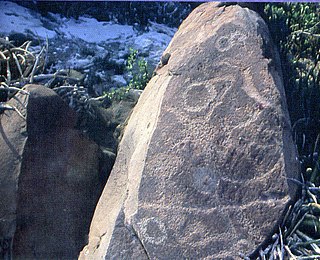 W
WBoca de Potrerillos is an archeological site located some 14 km from the municipal head of Mina, Nuevo León, México. About 60 km north east from Monterrey within the inter-sierra valleys of the Sierra Madre Oriental is the “mouth” or entrance to the Potrerillos Canyon between the Zorra and Antrisco hills. The site covers an area of about 6 km².
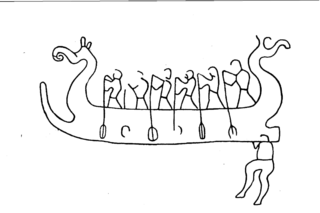 W
WThe Rock carvings of Boglösa in the province of Uppland in central Sweden are located to the southeast of Enköping. The three petroglyphs form part of a complex of rock art. They derive from the Swedish Bronze Age and the Iron Age. They are:Boglösa Kyrka, near the church; Brandskogen, 900 m west of Boglösa Kyrka Rickeby, near the church
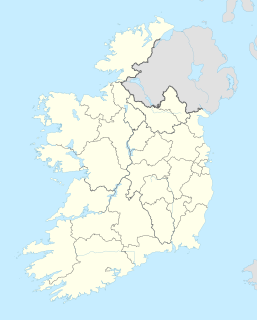 W
WThe Boheh Stone, also called St. Patrick's Chair. is a piece of rock art a and National Monument located in County Mayo, Ireland.
 W
WCaicara del Orinoco is a town in, and the administrative seat of, Cedeño Municipality, Bolívar State, Venezuela. It was founded in the middle of the Eighteenth Century.
 W
WThe Prehistoric Rock-Art Site of the Côa Valley is an open-air Paleolithic archaeological site located in northeastern Portugal, near the border with Spain.
 W
WThe Cochno Stone is a large cup and ring marked rock at Auchnacraig, Faifley, West Dunbartonshire, Scotland, next to the Cochno farm. It is also known variously as "Whitehill 1" and "the Druid Stone".
 W
WA cross is a geometrical figure consisting of two intersecting lines or bars, usually perpendicular to each other. The lines usually run vertically and horizontally. A cross of oblique lines, in the shape of the Latin letter X, is also termed a saltire in heraldic terminology.
 W
WDown Rope is a coastal area on the southeast coast of Pitcairn Island in the south Pacific, to the east of the Aute Valley and north of Break Jim Hip, it lies on the eastern side of an inlet and contains large petroglyphs on the rock face, testament to the Polynesian settlers of centuries ago. It is described as "a steep cliff located on the southern coast south of Ned Young's Ground, and west of St Paul's Point. At its foot, despite its perilous descent, is a popular picnic area and Pitcairn's only beach." The descent from the cliff top is said to be "spine chilling". There is anchorage at Down Rope and ignimbrite is also found in the vicinity.
 W
WThe El Cerro Tome Site is a site of petroglyphs and other prehistoric artifacts near Tome, New Mexico which was listed on the National Register of Historic Places in 1996.
 W
WThe High Banks cup and ring markings are a series of Neolithic or Bronze Age carvings on an outcrop of rock near High Banks farm, 3 km SE of Kirkcudbright, Dumfries and Galloway. They are one of the best collections of cup and ring markings in Galloway.
 W
WThe Kanozero Petroglyphs are a set of rock drawings discovered in 1997 on an island in Lake Kanozero in the southwestern part of the Kola Peninsula in Murmansk Oblast, Russia. The petroglyphs has been dated to the 2nd and 3rd millennium BC. There are about 850 different drawings at the site. Their meaning is not yet deciphered.
 W
WThe Kupgal petroglyphs are works of rock art found at Kupgal in Bellary district of Karnataka, India. Thousands of petroglyphs have been found at Kupgal, which date to the neolithic or even the old stone age. The site, which includes examples of rock gongs, was discovered first in 1892, but subsequently became lost to researchers until it was rediscovered in the early 21st century. This site features peculiar rock formations with unusual depressions which make musical sounds when struck with boulders.
 W
WThe Mandbjerghøj is located next to the road through Øster Velling Skov forest, north of Øster Velling, west of Randers in Jutland, Denmark. Here there are two small granite boulders with engraved geometric patterns from the Bronze Age. A granite Fredningssten marks the spot.
 W
WThe Massleberg 1 rock art are located near Strömstad in Bohuslän, in south-western Sweden, some 80 metres from the Massleberg grave field. On a rock face, several partially overlapping carvings from the Bronze Age can be seen.
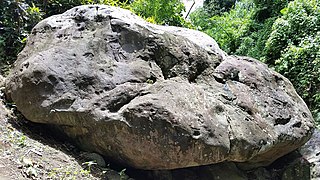 W
WThe Mt. Rich Petroglyphs are a series of pre-Columbian petroglyphs, set deep in a ravine along the Saint Patrick River in Mt. Rich, Grenada. The site consists of several boulders, the largest of which contains over 60 engravings. Two "workstones" can also be found nearby, comprising six cupules.
 W
WPecked curvilinear nucleated, (PCN) in archaeology, is a form of prehistoric rock carving. The term was originally proposed by Teresa Miller and Reed Haslam in 1976 to describe a widespread type of rock carving in western North America. The form is characterized by a circular or oval groove element, which results in a raised center area. The form is quite prevalent in California and is applied to a number of Native American rock carving sites in this portion of the United States.
 W
WThe Stone of the Goats is a petroglyph located in a pine forest near the village of Figueirido, in the Barbanza Region of Galicia.
 W
WPetroglyphs of Sikachi-Alyan are Petroglyphs on basalt rocks located near the Sikachi-Alyan Nanai village.
 W
WThe Rock Carvings in Tanum are a collection of petroglyphs near Tanumshede, Bohuslän, Sweden, which were declared a World Heritage Site by UNESCO in 1994 because of their high concentration.
 W
WThe rock drawings in Valcamonica are located in the Province of Brescia, Italy, and constitute the largest collections of prehistoric petroglyphs in the world. The collection was recognized by Unesco in 1979 and was Italy's first recognized World Heritage Site. Unesco has formally recognized more than 140,000 figures and symbols, but new discoveries have increased the number of catalogued incisions to between 200,000 and 300,000. The petroglyphs are spread on all surfaces of the valley, but concentrated in the areas of Darfo Boario Terme, Capo di Ponte, Nadro, Cimbergo and Paspardo.
 W
WThe Swastika Stone is a stone adorned with a design that resembles a swastika, located on the Woodhouse Crag on the northern edge of Ilkley Moor in West Yorkshire. The design has a double outline with five curved arms enclosing several so-called 'cup' marks, the like of which can be found on other stones nearby.
 W
WJames L. Swauger was an American archaeologist known for his work on the petroglyphs of the Ohio River valley of the United States. A native of West Newton in Westmoreland County, Pennsylvania, he moved to the Pittsburgh suburb of Edgewood in his youth; there he lived for most of the rest of his life.
 W
WTrialeti petroglyphs is prehistoric rock art in the Trialeti area, in the Tsalka Municipality, engraved over a number of periods from the Mesolithic to the Middle Bronze Age. The depictions include geometric, zoomorphic and anthropomorphic images. It is recognized as a monument of the Cultural Heritage of Georgia and is part of the Prehistoric Rock Art Trails, a cultural route designated by the Council of Europe.
 W
WThe Ukhtasar Petroglyphs are rock-carvings found on Mount Ukhtasar "Pilgrim Mountain", near the town of Sisian in Armenia's southern province of Syunik.
 W
WUsgalimal rock engravings or Usgalimal Petroglyphs at Usgalimal village, in South Goa, is one of the most important prehistoric sites in western India.
 W
WThe Vallée des Merveilles, also known in Italian as the Valle delle Meraviglie, is a part of the Mercantour National Park in southern France. It holds the largest quantity of open-air Bronze Age petroglyphs in Europe, after Val Camonica in Italy, and is given special note for the area's inclusion for the European Diploma of Protected Areas.
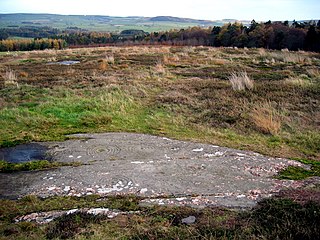 W
WWeetwood Moor near Wooler, Northumberland is a moor in the North of England which contains a scheduled monument. It has 26 known panels of Cup and ring mark petroglyphs carved into the sandstone.
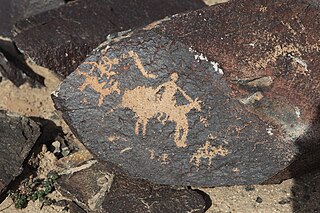 W
WYinshan Rock Paintings or Rock Paintings of Yinshan Mountains, also known as Petroglyphs in the Yinshan Mountains or Rock Paintings of Yinshan Mountain, are images carved into the rocks of the Yin Mountains and are widely distributed, mainly on the cliffs of Wolf Mountain in the Inner Mongolia, with themes involving animals, figures, deities, artifacts, celestial bodies.